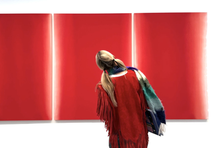Madame d'Ora: Master of Her Art
- The Courtauldian
- Aug 10, 2023
- 4 min read
by Lori Stranger | 29 November 2021
Dora Kallmus, better known as Madame d’Ora, was a prominent photographic portraitist in the 20th century. Photographing royalty, celebrities, and fashion icons, her studios in Vienna and Paris were highly successful yet her story has largely been forgotten. Her work has only recently been given the recognition it deserves with the Neue Galerie’s 2020 Madame d’Ora retrospective featuring the largest collection of her photographs to date in the United States. Born 12th March 1881 into an affluent Viennese Jewish family, d’Ora was passionate about photography from a young age. During a trip to the Côte d’Azur, she purchased her first camera in order to photograph the sites she visited. Upon returning to Vienna, she increasingly immersed herself in the Viennese art scene, and soon began an apprenticeship with the photographer, Nicola Perscheid. Her talent was undeniable, and in 1905, she became the first woman accepted by the Association of Austrian photographers as well as the first woman admitted into the Graphischen Bundes-Lehr- und Versuchsanstalt school. In 1907, her family’s finances and connections helped her open her own studio - Atelier d’Ora - which became one of the first woman-owned studios in Vienna. Her affluent Jewish background helped secure clients like the actor Bernhard Baumeister and opera singer Maria Jeritza. She also photographed avant-garde artists like Gustav Klimt (1907), and Egon Schiele. A 1909 exhibition of her work received widespread critical acclaim resulting in even more prestigious commissions.

Madame d’Ora, Gustav Klimt, 1907.
In the following years, her prestigious commissions and popularity rapidly increased. d’Ora’s keen perception meant that she was able to successfully execute her clients wishes. She effectively balanced her clients’ high status’, whilst imbuing an intimate informality and approachability to their portrayals that radically departed from conventional portraiture. Her 1915 portrait of Archdule Karl and Archduchess Zita with their Children captures a seemingly spontaneous moment of the Archduke’s family. Rather than a rigid, authoritative patriarch, d’Ora photographs the Archduke gently standing at the back of the room watching over his children while his wife lovingly holds their youngest child. She continued to gain prestigious clients, and in 1916, she was commissioned to photograph Emperor Charles I of Austria. However, it is arguably d’Ora’s celebrity photographs that feature her best work. Her 1922 Elsie Altmann-Loos Portrait represents the famous actress in a sensual pose. Her left breast is exposed while her direct gaze captures the viewer’s attention. The alluring picture echoes her previous client, Klimt’s renowned Judith und Holofernes I painting. d’Ora’s intelligence and charm meant her studio quickly became a meeting place for likeminded intellectuals.

Madame d’Ora, Elsie Altmann-Loos, 1922.
In 1925, d’Ora moved to Paris after being offered a job by the fashion magazine L’Officiel. She quickly immersed herself in the Parisian fashion industry, becoming fast friends with fashion icons like Cristóbal Balenciaga. Balenciaga would often commission d’Ora to photograph his latest couture designs, and her fashion photographs featured in high profile magazines like Tatler, Vanity Fair and Vogue Paris. She continued to capture the portraits of glamorous society, such as the figures of Coco Chanel, art deco artist Tamara de Lempicka, actor and singer Maurice Chevalier, and Josephine Baker. She also did not shy away from more controversial clients, such as the bisexual dancer Anita Berber and her lover, Sebastian Droste. Their naked dance performances titled ‘Cocaine’ and ‘Morphium’ had already scandalised Parisian society.

Madame d’Ora, Josephine Baker, 1928.
The outbreak of World War Two drastically changed d’Ora’s work. Although d’Ora had converted to Catholicism in 1919, her Jewish background still put her at risk. In 1940, following the German’s invasion of Paris, d’Ora’s studio was forcibly closed. She went into hiding for the rest of the war in the southeast province of Ardèche. Many of her family and friends, including her sister, Anna Kallmus, were killed in Chelmno concentration camp. After the war, d’Ora’s photographs understandably took a darker turn. She continued to produce society portraits but the lighting and poses notably possessed a more brooding quality. Her 1954 Colette shows the ageing writer against a dark background. D’Ora emphasises the writer’s wrinkled face and wiry hair as Colette contemplatively gazes into the distance.

Madame d’Ora, Colette, 1954.
Around 1948, the United Nations commissioned d’Ora to produce a series representing refugees and displaced people. The result was a powerfully stunning series full of emotional depth and tragedy. Between 1949 and 1958 she focused on her ‘big final work’. Visiting many Parisian slaughterhouses, d’Ora took photos of the butchered animals, no doubt an allusion to the Nazi’s horrifying reign. d’Ora eventually returned to Vienna after she gained back control of her house which had previously been seized by the Nazis. She died on the 28th of October, 1963.

Madame d’Ora, In a Refugee Camp, (Salzburg?), 1948.
d’Ora was a remarkable artist, and created around 200,000 photographs during her long career. She forged a path for women in a male dominated field whilst gaining the esteem and friendship of high-profile clients. Her powerful, vibrant portraits greatly affected subsequent photographers like Edith Glogau, Edith Barakovitch, Trude Geiringer, and Dora Horovitz. She captured the glamour and tragedy of her time, and her photographs should be afforded the recognition and admiration they so clearly deserve. Bibliography: ‘Madame d’Ora’. Neue Galerie. Accessed 15th November 2021. https://www.neuegalerie.org/madame-dora ‘Madame d’Ora’. Jewish Women’s Archive. Accessed 15th November 2021. https://jwa.org/encyclopedia/article/madame-dora ‘Make Me Look Beautiful, Madame D’Ora!’. Leopold Museum. Accessed 15th November 2021. https://www.leopoldmuseum.org/en/press/press-materials/1016/MAKE-ME-LOOK-BEAUTIFUL-MADAME-DORA












Comments